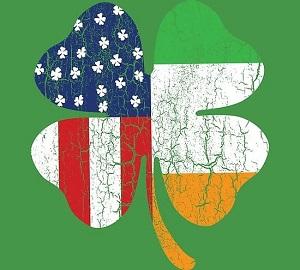The arrival of the Irish in the Americas, and their growth to gain an identity as Americans, is a complex one. Contributing factors include the passage of time, a loss of homogeneity, geographic expansion, economic and labor struggles, and like most emerging ethnicities, stereotyping.
The first large wave of Irish came to this country as the result of the invasion of Ireland by Oliver Cromwell driven by his concurrent persecution of Catholics. This led to what is now North Ireland, the formation of Ulstermen (and women) as a semi-autonomous populace, and the carve out of a colonization effort by the English powers using Scottish highlanders displaced to Ireland to breed out Catholics and replace them with Protestants.
The largest wave of Irish, however, began arriving in the mid-1830’s, when the Irish potato famine, a blight of microscopic insects, destroyed half a generation of Ireland’s potato crops. Known as “the Great Hunger” or in Irish Gaelic, An Gorta Mór, the famine lasted from 1820 to 1860, with dire consequences for the Ireland populace. During that period, Irish men, women and children constituted 33% of all immigrants to the United States; just over 2 million starving souls arrived - mostly in the Northeastern United States. Concurrently, due to disease, death, immigration due to famine, the population of Ireland was reduced from 8.5 million people to 4.5 million, a 50% reduction in population in 2 generations - 25% of whom came to the United States.
Many “famine” Irish came to the American shores as indentured servants, a great number of whom did not survive long enough to fulfill the terms of their indentured tenure due to the extreme labor thrust upon them. The non-indentured Irish immigrants, abundant and overflowing poor city areas, became a readily available labor source; easily disposable as laborers in dangerous endeavors. These new arrivals became a high percentage of the fodder for the cannons of labor which helped to fire the mid-1800’s Industrial Revolution in the United States. A great number of Irish, including vast numbers of single women along with children as young as 5, worked in the early manufacturing mills of the northeastern United States. Because the Irish immigrants were Celts – and not Anglo-Saxons – they were considered inferior by most Americans of the time. As a result, the Irish made up much of the prison, poorhouse, and asylum populaces of that era. An abbreviated perusal of any of the periodicals of the early and mid-1800’s – Puck, Harper’s, etc. – will provide ample, even daily, examples of caricatures of the Irish as low bred brawling drunks occupying the lower rungs of society.
Upon arrival in the early and mid-1800’s, many Irish, especially the Catholic Irish, were crowded into city slums in tight quarters, living in squalor in most instances. As the country expanded westward, many Irish took advantage of the opportunity to leave mill work in exchange for the opportunity to own their own land. Outside of Boston and some enclaves in New York City, Chicago, Cleveland, and Philadelphia, the western Irish American progression left fewer and fewer canonical neighborhoods of Irish American immigrants. In so losing these enclaves, much of the Irish American culture was dissipated and replaced with a uniquely American culture being distilled by the western frontier. In modern times, most American families who have any Irish heritage simply know it from their surnames (and some of whom are mistaken as their names are Scottish rather than Irish, as there is vast difference between the two populaces).
Irish Americans are many things. Here is what they are not: Scotch-Irish (Scotch is a drink, Scots are people…..); ignorant (despite scientists of the early 1800’s in England proclaiming Irish were more related to apes than any other northern hemisphere demographic); red-headed (red-heads are among the rarest of Irish, so rare they have their own convention in County Cork each year); mascots (such are a combination of pre-Vaudeville street show stereotypes and slick 1960’s marketing to promote sports mascots, cereal and some brands of beer); and no more violent than any other ethnic group (Ireland ranks among the highest of the UN’s least violent tourism countries).
Here is what Irish Americans are: well-traveled (all 3,142 counties in the United States have at least one person of Irish descendancy residing in their borders); prolific (30.4 million or 9.5% of our population have Irish ancestry); still coming to our shores (111,886 Irish nationals lived in the US as of 2019); and our leaders (12 United States Presidents, including Barack Obama, have direct ancestors from Ireland).
Most of all, Irish Americans are, first and foremost, Americans. As are many Americans, they are appreciative of the opportunities our shores have provided them, past and present, proudly so.
Benjamin A. Leonard is the Managing Partner of the firm’s Atlanta office.

